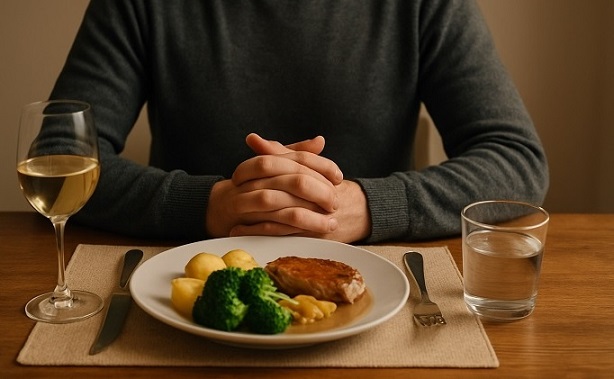
In Germany, the dinner table is more than a place to eat – it’s a place to express respect, structure, and social awareness. Unlike casual eating norms in some countries, German dining etiquette includes a surprisingly rich set of gestures, hand placements, and rules around cutlery that can either impress or confuse unprepared guests.
Whether you’re sitting down to a formal dinner in Munich or enjoying lunch with a local family in the Black Forest, knowing how to behave with your hands and utensils sends a clear message: you understand the rhythm of German hospitality.
This guide covers all the essentials of non-verbal etiquette at the German table – from where your hands should go, to how to use your fork and knife, to the subtle cues that say “I’m finished.”
Why Gestures and Hand Placement Matter
In German culture, small actions signal big values. Keeping your hands on the table (rather than in your lap) shows openness and presence. Proper cutlery use reflects upbringing and attention to detail. Even how you rest your silverware can communicate your mood, your manners, and whether you’re finished eating.
These behaviors stem from broader cultural values like Ordnung (order), Klarheit (clarity), and Respekt (respect). So while you may not be judged harshly for every faux pas, mastering these habits shows that you’ve taken the time to understand German social codes.
➡️ Related: Dining with Germans: Table Manners That Will Impress
Hands on the Table – But Not Your Elbows
In Germany, it’s considered polite to keep your hands visible during the meal. That means:
- Wrists or forearms lightly resting on the edge of the table
- Hands always above the surface, never in your lap
- Elbows off the table – resting elbows is seen as lazy or sloppy
Why? It shows attentiveness, participation, and hygiene. Hiding your hands can signal disinterest or nervousness. Especially in formal settings, proper hand placement reflects discipline and respect for those around you.
Fork in the Left, Knife in the Right – The Continental Style
Germans follow the continental style of cutlery use:
- Fork stays in the left hand
- Knife stays in the right hand
- Food is cut and brought to the mouth without switching hands
This differs from the American “cut and switch” method. In Germany, cutting food and placing it in your mouth with the same hand is considered smoother, neater, and more sophisticated.
Using Utensils Gracefully
- Hold cutlery gently – no stabbing or sawing
- Cut one bite at a time (don’t slice up your whole plate)
- Avoid clinking utensils loudly or waving them in the air while talking
- Don’t lick your knife or scrape your plate noisily
Utensils should be treated like tools of quiet efficiency, not attention-grabbing props.
What About Spoon and Soup Etiquette?
When eating soup or a dish that requires a spoon:
- Spoon away from yourself, not toward you
- Sip quietly (no slurping)
- Rest the spoon on the plate under the bowl, not in the bowl itself
If you need bread, break it with your hands – don’t use cutlery or smear butter with your dinner knife.
Napkin Usage: Follow the Host
Your napkin (Serviette) should be placed on your lap shortly after everyone is seated and the host begins. In formal settings, wait until the host unfolds theirs. Use it discreetly to dab your mouth. Never use it to wipe your face or nose.
When leaving the table temporarily, place the napkin loosely beside your plate. At the end of the meal, fold it loosely and place it to the left of your plate – not on the chair, and not refolded.
The Language of Cutlery: “Still Eating” vs. “Finished”
In Germany, your utensils say more than you think. Here’s what they communicate:
- Still eating: Knife and fork crossed on the plate, handles pointing down and out
- Finished: Knife and fork placed parallel, diagonally across the plate (4 o’clock position)
- Pause: Knife and fork laid in an inverted V
These signals help servers and hosts avoid awkward interruptions.
How to Handle Shared Dishes and Serving Utensils
- Always use the serving spoon or fork provided – never your personal cutlery
- Wait your turn – don’t reach across others
- Offer the dish politely to someone else before taking seconds
If bread is passed, take a piece and pass the basket – don’t pick through for your favorite slice.
Gestures to Avoid at the German Table
- Pointing with cutlery: Considered rude
- Licking fingers: Not acceptable
- Drumming fingers or tapping silverware: Impatient or childish
- Waving utensils while speaking: Distracting and informal
- Using toothpicks at the table (especially without covering your mouth): Highly impolite
Nonverbal Respect During Toasts
When someone initiates a toast (e.g., “Prost!”), make eye contact with each person you clink glasses with. Failing to do so is seen as impolite – and some say it brings bad luck. Use your right hand when toasting, and clink gently.
If you’re not drinking alcohol, raise your glass anyway and nod.
➡️ More in: The Toast and the Tip: How to End a German Meal Properly
What to Do with Your Hands When Not Eating
- Keep them resting near your plate
- Nod, gesture mildly when speaking, but don’t overuse hands
- Fold hands lightly if listening for a long time
- Never place hands under the table or behind your head
For Children and Newcomers
German children learn cutlery rules early – and guests are gently expected to follow them. If you’re new, do your best. Most hosts will appreciate the effort and offer helpful corrections kindly.
Cultural Values Behind the Gestures
| German Value | Dining Expression |
|---|---|
| Ordnung | Consistent hand placement and posture |
| Respekt | Clean, quiet utensil use |
| Aufmerksamkeit | Visible, attentive participation |
| Klarheit | Clear signals through cutlery placement |
Common Questions and Missteps
Q: What if I drop a fork?
A: Say “Entschuldigung” and discreetly ask for a new one – don’t pick it up and keep using it.
Q: Should I fold my hands to pray before eating?
A: Only if the host does – religious gestures are private and rare outside traditional families.
Q: Can I eat pizza or burgers with my hands?
A: In casual settings, yes. But in formal dining, use cutlery unless everyone else uses hands.
➡️ Don’t miss: From Kaffee to Kompliment: Dining Invitations and How to Respond in Germany
Final Thoughts
Mastering German dining gestures doesn’t require perfection – just awareness and a willingness to adapt. Keep your hands where they belong, handle utensils respectfully, and let your actions speak just as clearly as your words.
These small gestures create a big impression, signaling that you’re not just a visitor – you’re a respectful participant in one of Germany’s most enduring cultural rituals.
Related articles:
➡️ Dining with Germans: Table Manners That Will Impress
➡️ German Table Talk: What to Say (and What Not to Say) at Dinner
➡️ From Kaffee to Kompliment: Dining Invitations and How to Respond in Germany
➡️ The Toast and the Tip: How to End a German Meal Properly







